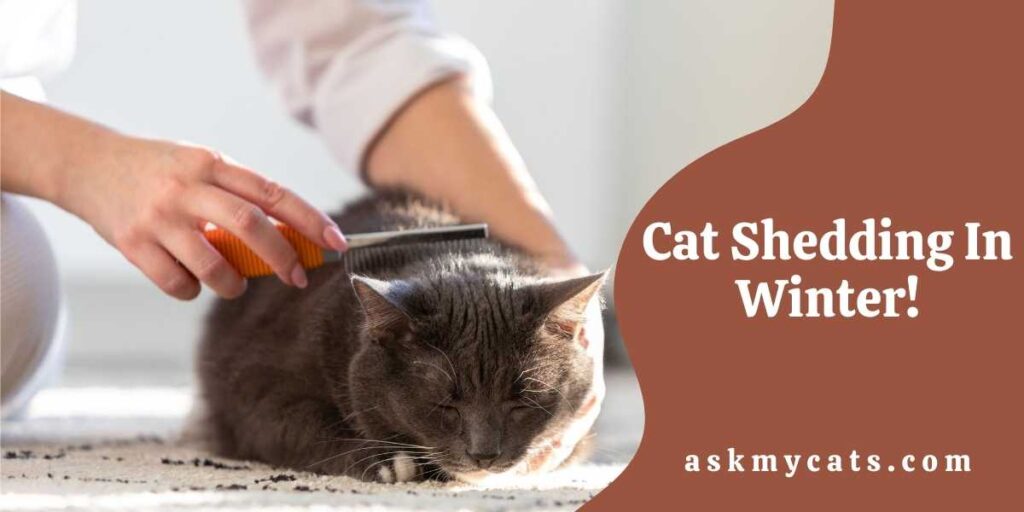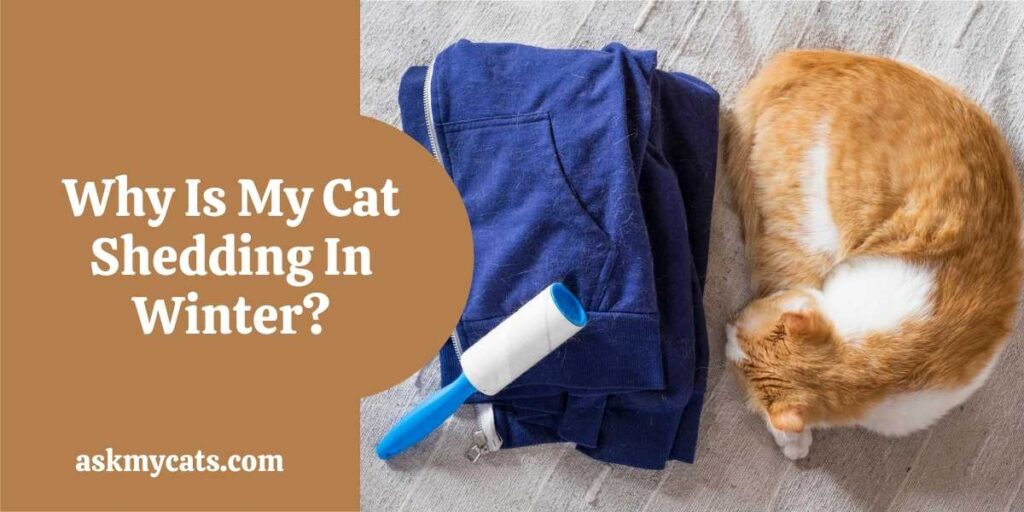The fact is that cat shedding is a normal and natural part of a cat’s existence. Hair growth and shedding occur in humans as well. Shedding is the process through which animals renew and maintain their fur.
In the wild, cats shed their coats in the winter to get rid of the thick winter undercoat after surviving the cold weather and prepare for the “grow-in” of the following season’s undercoat.
However, by domesticating cats and subjecting them to air conditioning in the summer and artificial heat in the winter, their systems have become sufficiently confused to cause them to shed constantly. This is very normal.


Give Your Cat the Perfect Day
Get the Free Ebook!
Do Cats Shed More In Winter?
YES, Cats usually shed more in winter.

Cats shed to clean their bodies of dead fur. Dead fur should be removed since it might irritate the skin. The cat’s body will lose the dead fur if it is not removed by combing and brushing.
Because ill cats do not lose their hair, shedding is thought to be a sign of health in cats.
Shedding can occur for various reasons, but it is mostly determined by how much time your cat spends outside and whether or not your cat is an exclusively indoor cat. The “photoperiod” is used to describe how much sunshine influences shedding.
The shedding process is triggered by the number of hours a cat is exposed to sunshine in a day (photoperiod).
Furthermore, shedding differs significantly between breeds. Because of the artificial light and the regulated temperature in your home, indoor cats shed at any time of year, and the volume of shedding hair is less than outdoor cats.
When the days begin to lengthen and spend more time outside in the spring, outdoor cats shed. During the winter, you won’t see much, if any, shedding from your outdoor cat since it will naturally hang on to all of its hair as a form of thermal insulation against the cold.
Shedding in cats may be managed by brushing and combing regularly. Brushing and combing a cat’s skin and coat daily eliminates loose and dead hair and keeps the skin and coat healthy. Cats with healthy fur coats that are groomed regularly shed less.
Must Read: Do Cats Get Dandruff In Winter?
Why Is My Cat Shedding In Winter?
Cats start shedding their thick winter coats after the winter season.

Seasonal shedding is more typical among wild cats and those that spend a significant amount of time outside.
Indoor cats are exposed to artificial lights that disrupt their circadian cycle, resulting in year-round shedding rather than seasonal shedding. This, too, is quite normal.
Cats that shed in the spring shed their thick winter fur, which helps them stay cool in the summer. They’ll grow a fresh coat to prepare for the winter in the fall.
Regardless of when your cat sheds, it is a vital and normal process. Dead fur can irritate the skin and must be removed through shedding.
It’s normal for cats to shed, and if yours doesn’t, it might indicate bad nutrition or medical problems.
If your cat sheds excessively, the same might be stated. Keep your eyes peeled. Take your cat to the doctor if they are shedding more than normal or if you find bald spots or a very thin coat.
Brushing your cat regularly is the best approach to take rid of extra hair at the source before it begins flying around your house or becoming hairballs in your cat.
The length and thickness of your cat’s coat are strong indicators of how often you should brush them. Your cat’s breed will frequently dictate the type of coat they have and how much they shed.
You might also like to check out reasons for cat shedding fur in clumps
Tips to Deal With Winter Shedding in Cats
Before you worry about controlling your cat’s shedding, you must first determine if your cat sheds normally or excessively.
Their breed will determine your cat’s level of shedding and if they are an indoor-only cat. It’s critical to know what’s typical for your pet and keep an eye on their health if there’s something more serious going on.
1. Regular Brushing
The longer you brush your cat, the more loose fur that lingers on his coat will be captured before it ends up all over your house. Three times each week is an excellent schedule.
Depending on your cat’s breed and hair length, you can use a wide-tooth comb, wire brush, or soft bristle brush.
Brushing your cat removes dirt and dandruff from their fur and provides a wonderful time for you and your feline companion to interact.
Must Read: How Cold Can Cats Survive Outside?
2. Proper Hydration
Hydration is vital for your cat’s overall health, but it’s also a terrific method to cut down on excess shedding. The healthier your cat’s coat is, the more hydrated they are.
Switching the sort of water dish you have is an excellent strategy to enhance your cat’s water consumption.
Cats like to drink moving water from streams or rivers in the wild, so motionless water in a water dish isn’t as appealing to them. A water fountain that cycles and circulates the water all the time appeals to their instincts and encourages them to drink more.
On the other hand, Cats have a low thirst drive-by nature; thus, increasing the moisture in their diet is the greatest approach to keep them hydrated.
You may achieve this by giving them more canned food or adding toppings to their kibble, like broth.
You might also like to read about do cats shed more in the summer
3. Maintain Diet
Your cat’s coat will get dull, and they will shed more if they aren’t getting all of the vitamins and nutrients they require. As a result of an allergic reaction to specific substances in their diet, some cats might develop skin irritations.
Consult a veterinarian and a pet nutritionist to determine the ideal diet for your cat’s breed, age, and weight.
A diet rich in omega-3 fatty acids and oils will promote a healthy, lustrous fur coat in general.
4. Give A Good Bath
If you’re feeling bold, a bath may help remove unwanted hair from your cat’s coat as well as soothe and moisturize their skin if they have any irritants or allergies.
Like when you shower, a constant spray of water eliminates hair, grime, and dander from your cat’s coat. However, instead of using your ordinary shampoo, make sure you use the right soap for your cat’s fur.
Bathe your cat just as needed; cats are natural groomers. Bathing once a month might suffice as a good starting point.
5. Reduce Stress
Excessive shedding in cats can be a stress response, so make sure they relax in a peaceful, calming environment.
Create a cat-only zone in your home if you have other animals, such as a dog, that could be causing your cat discomfort. This may be a spare bedroom or a basement that you can secure with a kid latch or a baby gate.
Make use of whatever vertical space you can create with shelves or cat trees if you live in a tiny place. Your cat will be able to explore the space freshly without feeling restricted by the other animals in the house.
Interesting Read: Do Black Cats Have Dandruff?
6. Use Lint Rollers
Unfortunately, shedding is inevitable, regardless of how healthy and hydrated your cat is. A reliable lint roller is one of the greatest ways to control the fur in those situations.
This is the finest option for furniture and carpet. Vacuuming can help, but vacuums frequently miss tough hair attached to the surface. Lint rollers help to keep your furniture clean by providing additional support. In a pinch, a moist glove will suffice.
7. Laundry Time
While lint rollers are fantastic for cleaning furniture, they don’t always get all tough hair out of garments and fabrics. Regular white vinegar will be your new best buddy for these goods.
Toss your next batch of clothing into the dryer without the heat for a brief toss first. This keeps your washing machine from being clogged by allowing the lint trap to catch a lot of stray hair.
Then, add roughly 12 cups of white vinegar with your clothing to the washing machine. This not only removes the remaining fur from your clothing but also acts as a natural fabric softener and odor remover.
Also, check out the reasons behind older cat shedding excessively
Is It Normal For Cats To Shed A Lot In Winter?
Yes, it is normal for cats to shed excessively in winter.

Cats’ fur thinning and even patches of hair loss are normal as they become older. Cats’ hair can become white with age, much as humans’, but their whiskers can turn black.
Brushing your cat daily will assist in minimizing shedding. Cats groom themselves naturally. However, they might benefit from brushing regularly.
To prevent tugging the fur or making the experience painful, use the proper comb or brush for the length and density of your cat’s fur.
Interesting Read: Do Black Cats Shed?
Frequently Asked Questions
Why is my cat shedding chunks of hair?
If your cat starts losing hair in areas, clumps, or all over, it might indicate a larger health problem. Allergic responses, hormone imbalances, and insect infestations are common reasons for cat hair loss, also known as alopecia.
Why is my indoor cat shedding so much?
Cats, like us, shed their hair regularly. As the temperature warms up in the spring, cats tend to shed more hair. Stress, poor food, allergies, medicine, illness, and sunburn are among the medical conditions that cause cats to shed. Groom and brush your cat regularly.
How do I know if my cat is shedding too much?
When you detect more hair than normal, it indicates that your cat is shedding excessively. Another red flag is excessive grooming. Cats groom themselves up to half of the time they’re awake, according to WebMD.
Final Words
Cats shed all year, but when the days start to become longer at the end of the winter months, they shed their heavy winter coats.
This suggests there will most likely be more shedding at that time. To reduce the amount of hair falling in your home, brush your cat for a few minutes each day.
Ask your questions in the comments section below.
You might also like to read:
- Do Cats Need Winter Clothing?
- How To Keep Cats Warm Without Electricity?
- Can I Walk My Cat In Winter/Snow?
- Can I Bathe My Cat In Winter?
- Do Cats Drink Less Water In The Winter?
- Can Cats Live In A Garage In The Winter?
- Do Cats Go Into Heat In The Winter?
- Do Cats Have Kittens In Winter?
- How To Keep A Stray Cat Warm Outside In Winter?
- How To Keep Indoor Cats Warm In Winter?
- How Do Stray Cats Survive Winter?
- Do Cats Get Cold In The Winter?
- Can Cats Get Ticks In The Winter?
- Can Cats Get Fleas In The Winter?
- Do Cats Get A Winter Coat?
- Do Cats Sleep More in Winter?
- What To Feed Feral Cats In Winter?
- Do Cats Eat More In The Winter?
- Do Cats Really Like Snow?
- How to Bury a Cat During the Winter?
- Lost Cat in Winter? Here’s How to Find Them
